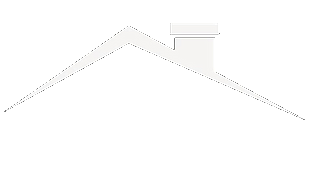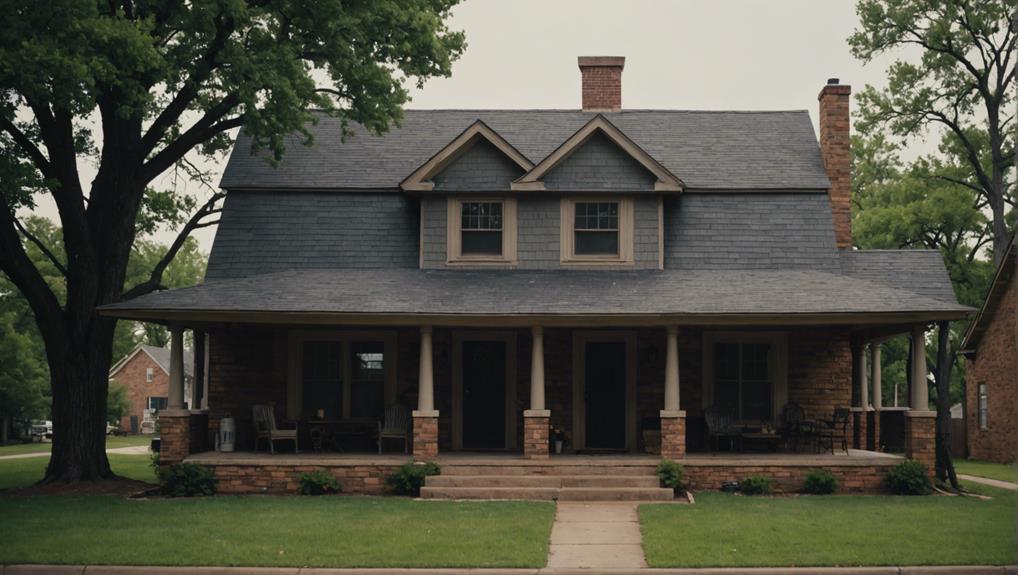When approaching Oklahoma's severe weather, did you know that your roof is particularly susceptible to damage? Taking proactive steps to prepare your roof can save you from significant repair costs and headaches down the line. By implementing a few key strategies, you can strengthen your roof against the harsh elements that Oklahoma's weather can bring. From securing loose flashing to reinforcing against strong winds, each step plays a crucial role in ensuring your roof's resilience. So, let's explore these essential preparations to safeguard your home in the face of Oklahoma's unpredictable climate.
Key Takeaways
- Secure roof components like flashing and shingles.
- Trim trees near the roof to prevent damage.
- Clean and maintain gutters for proper drainage.
- Review insurance policy for storm damage coverage.
- Use impact-resistant materials for hail protection.
Roof Inspection for Damages
Regularly inspect your roof for damages to guarantee its structural integrity and ability to withstand severe weather conditions in Oklahoma. A thorough roof inspection is essential to identify any issues that could compromise the roof's effectiveness.
Check for damaged shingles, such as missing or broken pieces, as they can leave your roof vulnerable to leaks and water damage. Look out for signs of water damage, like stains on the ceiling or walls, which may indicate a roof leak that needs immediate attention.
Oklahoma's extreme weather, including strong winds and heavy rainfall, can exacerbate existing vulnerabilities in your roof. By addressing damaged shingles promptly, you can prevent further deterioration and ensure your roof remains resilient against the harsh elements.
Securing Loose Flashing and Shingles
To guarantee the structural integrity of your roof and prevent water leaks, it's essential to promptly secure any loose flashing and shingles that may compromise its protection against severe weather conditions.
Here are some important steps to help you prepare your roof and prevent water damage:
- Inspect Flashing: Check for loose or damaged flashing around chimneys, vents, and roof edges.
- Secure Flashing: Confirm all flashing is securely fastened to prevent water infiltration.
- Check Shingles: Inspect for missing or damaged shingles that could compromise your roof's integrity.
- Repair Promptly: Address any loose or damaged shingles promptly to prevent further damage during severe weather.
Taking these proactive measures will help fortify your roof against the elements and minimize the risk of water damage. Remember, a well-maintained roof is your first line of defense against Oklahoma's unpredictable weather conditions.
Tree Trimming Near Roof
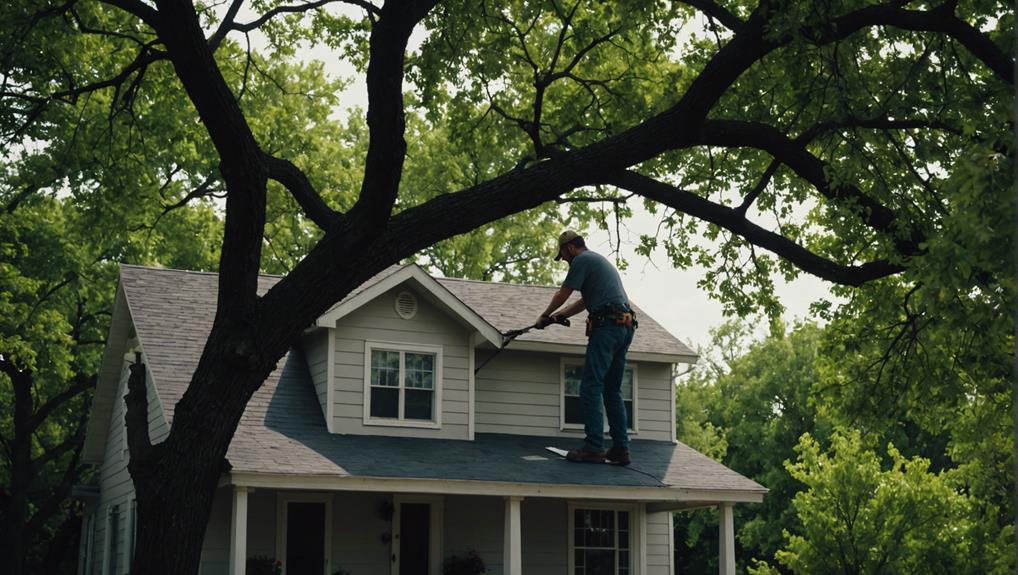
Trimming tree branches near your roof is essential for preventing damage during storms and safeguarding your property against potential risks. Overhanging branches can scratch or puncture the roof surface, potentially leading to leaks and structural issues. Regular tree trimming helps maintain the integrity of your roof, prolonging its lifespan and ensuring its durability against severe weather conditions. In addition, tree branches can provide pathways for pests and critters to access your roof, causing further damage. Proper tree trimming not only enhances the safety of your property but also minimizes the need for roof repairs due to tree-related issues. To better understand the importance of trimming tree branches near your roof, refer to the table below:
| Benefits of Tree Trimming Near Roof |
|---|
| Prevents damage during storms |
| Reduces risk of roof punctures |
| Extends roof lifespan |
| Minimizes pest access to the roof |
| Enhances overall property safety |
Gutters Cleaning and Maintenance
Ensuring your gutters are clean and well-maintained is essential for preventing water damage and preserving the integrity of your roof. Neglecting proper gutter maintenance can lead to costly repairs and compromise the structural integrity of your roof.
Here are some key points to take into account when caring for your gutters and downspouts:
- Regular gutter cleaning is vital to prevent water overflow and potential roof damage.
- Clogged gutters can result in water pooling and leaks within the roof structure.
- Proper gutter maintenance ensures efficient water drainage and helps prevent moisture-related issues.
- Cleaning your gutters reduces the risk of water infiltration, which can cause damage to both the roof and foundation of your home.
Reviewing Insurance Coverage
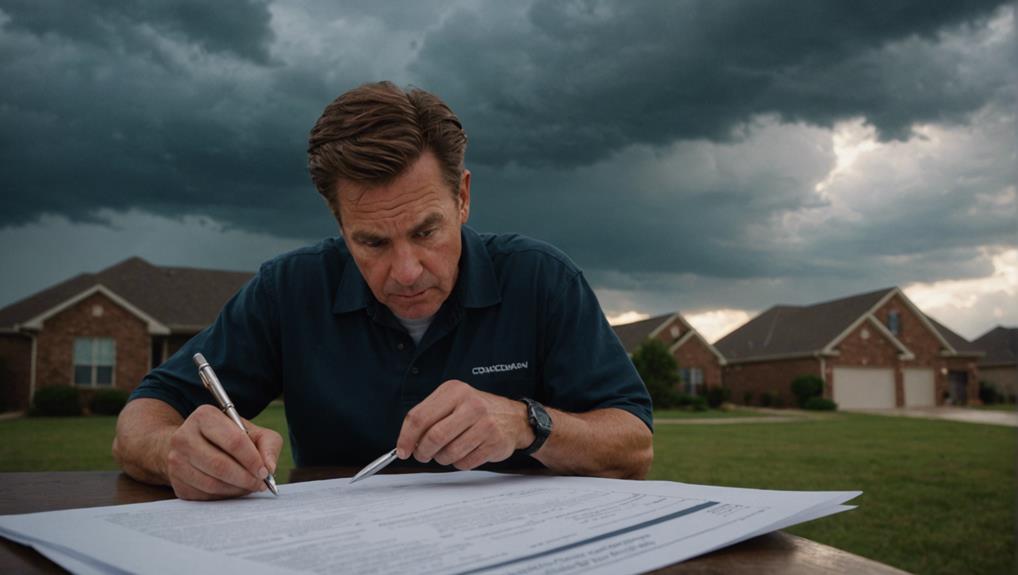
Before severe weather strikes, it's essential to review your homeowner's insurance policy carefully. Make sure to check for specific provisions related to hail, wind, and storm damage. Understanding your coverage limits and deductible amount for roof repairs is vital for being prepared.
Having this information readily available can help streamline the claims process and ensure you receive the necessary financial assistance to address any potential damage to your home. Remember to document any pre-existing damage and take photos of your property to provide evidence in case you need to file a claim. By being proactive and informed, you can better protect your home and belongings from the impact of severe weather events.
Coverage Assessment Tips
Curious about how to guarantee that your homeowner's insurance policy adequately covers your roof for severe weather damage in Oklahoma? To assess your coverage effectively, follow these tips:
- Review your homeowner's insurance policy to understand the extent of coverage for roof repairs or replacements.
- Assess the replacement cost coverage and deductible information provided by your insurance company.
- Verify if your policy includes specific coverage for severe weather events common in Oklahoma, such as hailstorms or tornadoes.
- Consider updating your insurance coverage annually to make sure sufficient protection against potential roof damage.
Remember to reach out to your insurance provider for any clarification on coverage details related to roof repairs and replacements.
Policy Review Checklist
To ensure thorough protection for your roof in Oklahoma, carefully reviewing your homeowner's insurance policy is vital. Make sure to verify the coverage your policy provides for potential roof damage caused by severe weather events common in Oklahoma.
Check the replacement cost coverage and deductible information specifically related to roof repairs. It's important to assess if your policy includes coverage for events like hailstorms or tornadoes.
Additionally, look for any exclusions or limitations that may affect your ability to file a claim for roof damage due to severe weather. Understanding the process and requirements for claim filing will help you navigate any potential roof repair needs efficiently in the event of severe weather in Oklahoma.
Understanding Coverage Limits
Review your homeowner's insurance policy to gain a clear understanding of the coverage limits for roof damage in Oklahoma. When reviewing your insurance policy, consider the following:
- Check for specific coverage for hail, wind, tornado, and other severe weather-related roof damage.
- Understand the deductible amount and replacement cost coverage provided by your insurance for roof repairs.
- Make sure your insurance policy includes coverage for potential roof damage caused by Oklahoma's severe weather conditions.
- Consult with your insurance provider to clarify any uncertainties regarding coverage limits for roof repairs in Oklahoma.
Being aware of your insurance coverage for roofing can help you prepare financially for any storm damage that may occur in Oklahoma City. Consider investing in impact-resistant shingles to mitigate potential weather-related damage.
Reinforcing Roof for Storms
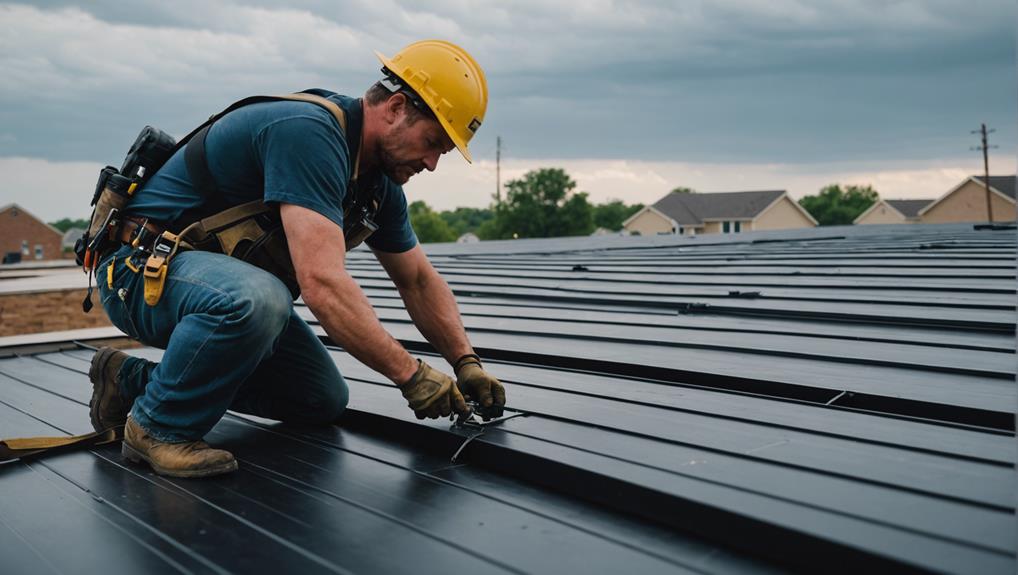
To reinforce your roof for storms in Oklahoma, start by securely fastening roof shingles to prevent them from being lifted by strong winds.
Installing hurricane straps can further strengthen the roof structure, reducing the risk of damage during severe weather.
Additionally, trimming tree branches near your roof can minimize the chances of them falling and causing impact damage during storms.
Secure Roof Shingles
Inspect and reinforce your roof shingles to fortify your home against the impact of severe weather conditions in Oklahoma.
- Verify all shingles are properly secured to prevent wind uplift and water infiltration.
- Use roofing adhesives to strengthen shingles and enhance their resistance to severe weather conditions.
- Replace any loose or damaged shingles to maintain the integrity of the roof structure.
- Consider using impact-resistant shingles to provide additional protection against storms.
Regularly inspecting and maintaining the condition of your roof shingles is essential in preventing water damage and ensuring the longevity of your roof. If needed, consult a roofing contractor to assist in securing your shingles and safeguarding your home from potential storm-related issues.
Install Hurricane Straps
Consider strengthening your roof for storms by installing hurricane straps. These metal connectors provide additional strength to secure the roof to the walls during severe weather conditions. Hurricane straps are essential for preventing the roof from lifting off your home in extreme weather events like hurricanes, tornadoes, or severe windstorms common in places such as Oklahoma.
These straps play an important role in protecting your home by reducing the risk of roof damage and structural failure. By investing in properly installed hurricane straps, you're taking a proactive measure to fortify your roof and enhance its ability to withstand the forces of nature.
Secure your roof, prevent roof lifting, and safeguard your home by installing hurricane straps before the next storm hits.
Trim Tree Branches
Strengthening your roof for storms involves proactive measures like trimming tree branches near your home to reinforce its resilience against severe weather conditions. Trimming tree branches near your house before the storm season hits can prevent them from causing significant damage to your roof.
Here are some key reasons why trimming trees near your roof is essential:
- Overhanging branches can scrape or puncture your roof during storms.
- Trimming reduces the risk of debris buildup that can lead to water damage.
- Close branches provide easy access for pests like squirrels and raccoons.
- Proper tree maintenance enhances safety by minimizing the potential for falling branches to damage your roof.
Protecting Against Hailstorms
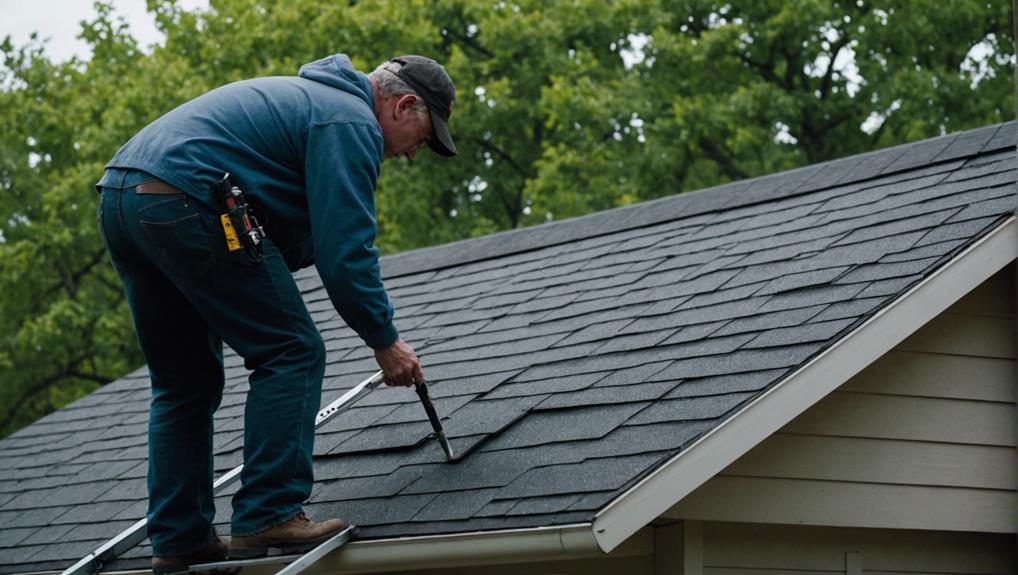
To fortify your roof against hailstorms, prioritize the use of impact-resistant roofing materials to minimize potential damage. Opting for impact-resistant roofing materials can greatly reduce the risk of hail damage.
Additionally, installing hail guards or screens on vulnerable areas of your roof can provide an extra layer of protection against hail impact. It's essential to regularly inspect your roof for any signs of hail damage and promptly repair any issues to prevent further deterioration.
Ensuring that all shingles or tiles are securely fastened is important in helping your roof withstand the impact of hailstorms.
In addition to impact-resistant materials and hail guards, applying adhesive sealant can offer extra protection against hail damage. This sealant can help reinforce the roof's integrity and prevent leaks caused by hail impact.
Strengthening Against Strong Winds
Securing loose components like flashing and vent covers is essential in minimizing wind damage to your roof. To further strengthen your roof against strong winds, consider the following steps:
- Use Adhesive Sealant: Apply adhesive sealant to reinforce shingles and prevent wind uplift, enhancing the overall stability of your roof.
- Install Additional Bracing: In tornado-prone areas, installing additional bracing can greatly strengthen the roof structure and improve its resistance to high winds.
- Trim Trees: Trim nearby trees to prevent damage from falling branches, reducing the risk of roof damage during storms with strong winds.
- Reinforce Vulnerable Areas: Reinforce roof edges and corners susceptible to wind uplift by using appropriate materials to fortify these weak points.
For expert assistance in reinforcing your roof against strong winds, consider consulting a professional roofing company. By taking these proactive measures, you can better prepare your roof to withstand Oklahoma's severe weather conditions.
Ensuring Proper Roof Drainage
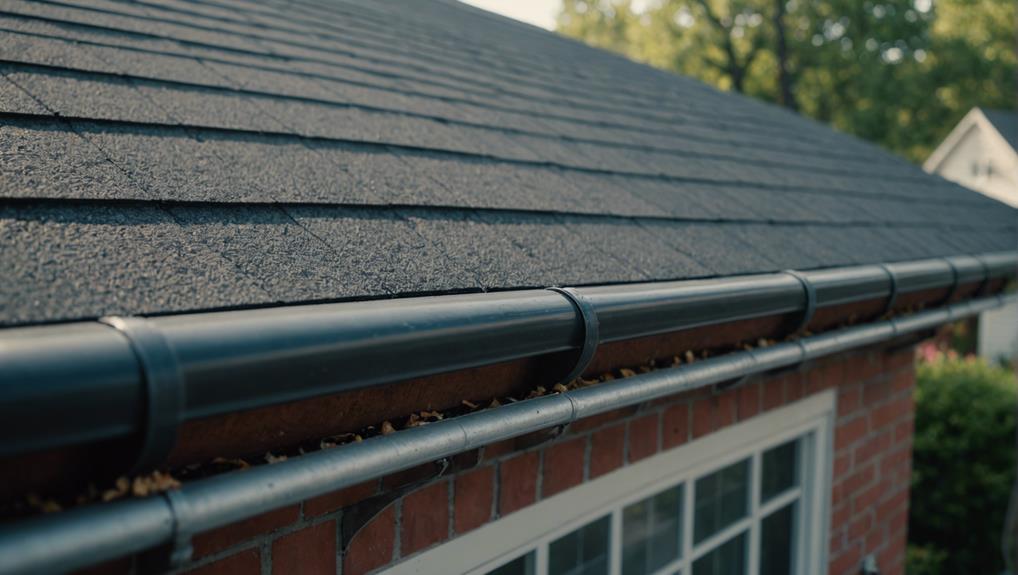
Maintain proper roof drainage by regularly cleaning gutters and downspouts to prevent clogging and maintain efficient water flow. Clogged gutters can lead to water backup, causing damage to the roof and potential leaks during heavy rains. Install gutter guards to prevent debris accumulation and make sure water can flow freely. It's essential to address any signs of damage promptly, such as missing shingles or granular loss, as these issues can impact the roof's ability to drain water effectively.
During high winds, proper roof drainage becomes even more important. Making sure that water can flow off the roof efficiently can help prevent water from seeping into the structure and causing damage. Conduct regular roof inspections to identify any issues that may impede drainage and fix them promptly.
Frequently Asked Questions
How Do I Prepare My Roof for a Storm?
Examine your roof for missing shingles, damaged areas, and weak spots. Secure loose components, reinforce vulnerable spots, and contemplate impact-resistant materials. Clean gutters, trim trees, and guarantee proper drainage for storm readiness.
How Do I Protect My Roof From a Storm?
To protect your roof from a storm, focus on maintenance, emergency repairs, weatherproofing techniques, regular roof inspection, storm damage prevention, and applying protective coatings. These actions can safeguard your roof from severe weather conditions.
What Is the Best Roof for Extreme Weather?
For extreme weather, consider metal roofs for durability, impact-resistant asphalt shingles for hail protection, and tile roofs for longevity and wind resistance. Synthetic slate/shake materials offer durability with traditional looks. Regular maintenance guarantees peak performance.
How Often Should You Replace Your Roof in Oklahoma?
When considering roof lifespan in Oklahoma, factors like weather impact and maintenance play important roles. Regular inspections, using durable roofing materials, and addressing replacement signs promptly can help extend your roof's lifespan.
Conclusion
As you fortify your roof against Oklahoma's harsh weather, remember that just like a sturdy roof protects a house, resilience shields us from life's storms.
By taking proactive steps to safeguard your roof, you aren't only protecting your home but also building a foundation of strength and preparedness for whatever challenges may come your way.
Stay vigilant, stay strong, and weather any storm that comes your way.

